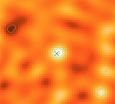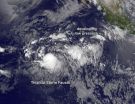(Press-News.org) Astronomers have studied the carbon monoxide in a galaxy over 12 billion light years from Earth and discovered that it's running out of gas, quite literally, and headed for a 'red and dead' future.
The galaxy, known as ALESS65, was observed by the Atacama Large Millimeter Array (ALMA) in 2011 and is one of less than 20 known distant galaxies to contain carbon monoxide.
Dr Minh Huynh from The University of Western Australia node of the International Centre for Radio Astronomy Research (ICRAR) led the team on their search for galactic carbon monoxide in work published today in the Monthly Notices of the Royal Astronomical Society.
"We're familiar with carbon monoxide here on Earth as the deadly gas that can cause suffocation, but in galaxies it plays an important role in the lifecycle of stars," said Huynh.
"Out of the galaxies that we know contain carbon monoxide, less than 20 are as far away from Earth as ALESS65. Out of the billions of galaxies out there, the detections are very rare!"
Huynh, who grew up in Perth, said that at first astronomers didn't think there could be massive 'red and dead' galaxies in the distant Universe, so studying galaxies heading towards that fate is important to solve the puzzle of their existence.
Using the Australia Telescope Compact Array (ATCA) radio telescope in NSW, Australia, Huynh and the team worked out how much carbon monoxide they could see in ALESS65 and extrapolated that out into how much fuel the galaxy has left – how much gas it has.
"All galaxies have a certain amount of fuel to make new stars," said Huynh.
"Our galaxy, the Milky Way, has about five billion years before it runs out of fuel and becomes 'red and dead', but ALESS65 is a gas guzzler and only has 10s of millions of years left – very fast in astronomical terms."
The team also combined their observations of the galaxy with the original data from ALMA to work out how similar ALESS65 is to galaxies nearer to Earth.
"We were able to work out the strength of the UV radiation in ALESS65; it's similar to some 'starbursting' galaxies in the local universe, but the stars in ALESS65 are forming in much larger areas when compared to local galaxies," said Huynh.
The team will now turn their attentions to the search for carbon monoxide in another galaxy near to ALESS65, named ALESS61.
"Finding and studying carbon monoxide in more galaxies will tell us even more about how stars formed in the early days of the Universe and help solve the mystery of far away 'red and dead' galaxies" said Huynh.
INFORMATION:
ICRAR is a joint venture between Curtin University and The University of Western Australia with support and funding from the State Government of Western Australia.
Original Publication
"Detection of molecular gas in an ALMA [CII]-identified Submillimetre Galaxy at z=4.44" Huynh et al. Monthly Notices of the Royal Astronomical Society (Oxford University Press), Published 9th of July 2014. Available at: http://mnrasl.oxfordjournals.org/lookup/doi/10.1093/mnrasl/slu077
Contacts
Dr Minh Huynh
ICRAR - UWA
Ph: +61 8 6488 4594
M: +61 413 698 670
E: minh.huynh@icrar.org
Kirsten Gottschalk
Media Contact, ICRAR
Ph: +61 8 6488 7771
M: +61 438 361 876
E: kirsten.gottschalk@icrar.org
David Stacey
Media Manager, UWA
Ph: +61 8 6488 3229
M: +61 432 637 716
E: david.stacey@uwa.edu.au
Carbon monoxide predicts 'red and dead' future of gas guzzler galaxy
2014-07-09
ELSE PRESS RELEASES FROM THIS DATE:
Health-care worker hand hygiene rates increase three-fold when auditors visible
2014-07-08
Hand hygiene rates were found to be three times higher when auditors were visible to healthcare workers than when there were no auditors present, according to a study in a major Canadian acute care hospital.
The study, titled, "Quantification of the Hawthorne effect in hand hygiene compliance monitoring using an electronic monitoring system: a retrospective cohort study," published today on-line in the BMJ Quality & Safety Journal, by first author Dr. Jocelyn Srigley, who did the study as part of her Master's thesis while a Clinical Fellow in Infection Prevention and ...
LJI develops new approach to identify genes poised to respond in asthma patients
2014-07-08
SAN DIEGO – July 8, 2014 In a study published yesterday in the scientific journal Nature Immunology, a group at the La Jolla Institute (LJI) led by Pandurangan Vijayanand, Ph.D. identify new genes that likely contribute to asthma, a disease that currently affects over 200 million people world wide.
An organism's genetic material, also known as its genome, can be divided into small sections or 'neighborhoods.' Scientists can determine which genetic neighborhoods in a cell are active, or primed for gene production, by looking for a marker on the genome called an enhancer. ...
Astronomers bring the third dimension to a doomed star's outburst
2014-07-08
VIDEO:
NASA Goddard astrophysicists Ted Gull and Tom Madura discuss Eta Carinae and their new model of the Homunculus Nebula, a shell of gas and dust ejected during the star's mid-19th...
Click here for more information.
In the middle of the 19th century, the massive binary system Eta Carinae underwent an eruption that ejected at least 10 times the sun's mass and made it the second-brightest star in the sky. Now, a team of astronomers has used extensive new observations to create ...
NASA's SDO spots a summer solar flare
2014-07-08
The sun emitted a mid-level solar flare, peaking at 12:20 p.m. EDT on July 8, 2014, and NASA's Solar Dynamics Observatory captured images of the event. Solar flares are powerful bursts of radiation. Harmful radiation from a flare cannot pass through Earth's atmosphere to physically affect humans on the ground, however -- when intense enough -- they can disturb the atmosphere in the layer where GPS and communications signals travel.
To see how this event may affect Earth, please visit NOAA's Space Weather Prediction Center at http://spaceweather.gov, the U.S. government's ...
NASA-JAXA's new precipitation satellite sees first Atlantic hurricane
2014-07-08
VIDEO:
The animation begins with global infrared data showing the progression of the storm as it forms into a hurricane. Then GPM flies overhead measuring rain rates on the ground. GPM's...
Click here for more information.
The Global Precipitation Measurement (GPM) Core Observatory flew over Hurricane Arthur five times between July 1 and July 5, 2014. Arthur is the first tropical cyclone of the 2014 Atlantic hurricane season.
GPM is a joint mission between NASA and the Japan ...
Satellite sees newborn Tropical Storm Fausto being 'chased'
2014-07-08
Tropical Storm Fausto was literally born yesterday and strengthened to a tropical storm quickly. Satellite imagery from NOAA's GOES-West satellite shows a rounded Fausto being "chased" by a developing area of low pressure to the east of the storm.
NOAA's Geostationary Operational Environmental Satellite GOES-West captured a combination visible and infrared image of the Eastern Pacific on July 8 at 1500 UTC (10 a.m. EDT). In the image, Tropical Storm Fausto appeared as a rounded area of clouds, compared to the amorphous developing low pressure area behind it.
At 6:30 ...
NCI study finds extreme obesity may shorten life expectancy up to 14 years
2014-07-08
Adults with extreme obesity have increased risks of dying at a young age from cancer and many other causes including heart disease, stroke, diabetes, and kidney and liver diseases, according to results of an analysis of data pooled from 20 large studies of people from three countries. The study, led by researchers from the National Cancer Institute (NCI), part of the National Institutes of Health, found that people with class III (or extreme) obesity had a dramatic reduction in life expectancy compared with people of normal weight. The findings appeared July 8, 2014, in ...
Virtual reality crowds produce real behavior insights
2014-07-08
VIDEO:
Researchers at Brown University have developed a wireless virtual reality system to better understand how pedestrians interact with one another and generate patterns of crowd movement.
Click here for more information.
PROVIDENCE, R.I. [Brown University] —The cognitive scientists in the Virtual Environment Navigation lab at Brown University are not only advancing a frontier of behavioral research but also of technology.
Led by Professor William Warren, the group developed ...
Three reforms to protect California's cap-and-trade policy
2014-07-08
California's landmark cap-and-trade system for regulating greenhouse gases could be vulnerable to price spikes and market manipulation, according to a new study released by scholars affiliated with the Energy Institute at Haas. But the state's air-quality regulators can prevent that outcome with three straightforward reforms, the study says.
Specifically, the California Air Resources Board should consider (1) strengthening the new market's price collar—the so-called allowance price containment reserve—(2) allowing permits to be converted from one compliance period to ...
Planet Mercury a result of early hit-and-run collisions
2014-07-08
TEMPE, Ariz. - Planet Mercury's unusual metal-rich composition has been a longstanding puzzle in planetary science. According to a study published online in Nature Geoscience July 6, Mercury and other unusually metal-rich objects in the solar system may be relics left behind by collisions in the early solar system that built the other planets.
The origin of planet Mercury has been a difficult question in planetary science because its composition is very different from that of the other terrestrial planets and the moon. This small, innermost planet has more than twice ...








